-

人教版高中英语必修4A taste of English Humor说课稿3篇
Then I would ask them to think of a funny English or Chinese and tell it to partners. While telling stories, they can use expressions and some acting to help make the story funny. 5 minutes would be given to do this.Those stories they told there will be the material for their writing. Soletting them tell it at first is helpful. And they can make a difference between telling a funny story and writing it down. Generally speaking, it is difficult forstudents to write well because they don’t know what to write and how to write. Asking them to tell their own stories at first can help them come up with what to write.After their telling, I would invite someone to share his/her story with all of us and I would write it down on the blackboard.This example story would be used as a sample to illustrate the format of funny story. Different from a story from teacher or textbook, a story from students can obviously become a interesting material to draw students’ attention.Then I would ask the whole class to put this story into several parts. It might be a little bit difficult for them. So I would ask them to find out whether all the sentences are necessary. After delete some sentences, there are 6 sentences left behind. Then they can easily put them into three parts. After interaction with students, I would teach them the right terms for each part and conclude the format of funny story.This step is the key and difficult point in my lesson. So I mainly usetask-based teaching method in this part and the task for students was divided into several stages. With the separated difficult level, students can find there are usually three parts in writing. They can also learn to write without the unnecessary parts in the process of analyzing. And then I wouldn’t rush to tell them the right terms to them directly. Instead, I would ask them to name them by their own. A confused mind is better for acquiring knowledge.While-writing:Then I would give students 7 minutes to write down this story, without other requirements.With all the preparations in pre-writing, students’ difficulties were cleared. So it would be much easier for them to write down the story within 7 minutes. There are no other requirements because students’ first writing is actually a drafting. It would be revise and edit several times later. Writing, as a skill

人教版高中英语必修3Festivals around the World说课稿3篇
Teaching plan for Unit 1 book3Good morning, teachers. It’s my great pleasure to be here because I can share my lesson with you and I can learn a lot from it. I’ll begin my lesson from the following four parts, the teaching material, the teaching methods, the studying methods and the teaching procedure.Firstly, let me talk about the teaching material. The content of my lesson is the reading passage festivals and celebrations of Unit 1 Festivals around the world. This passage is about festivals and celebrations. By studying this passage, we’ll enable the students to know that festivals exit everywhere, and many of festivals in different countries celebrate similar ideas. As we all know, the reading passage is the center of each unit. If the Ss can learn it well, it will be helpful to make the Ss learn the rest of this unit.After studying the teaching material, I think the teaching aims are as the followings:1. Knowledge aims:(1) The Ss can master the usage of the important words andexpressions.(2)The Ss can use the __________________ (grammar) in the proper situation.Make students know about the festivals all over the world and the detail of the festivals, such as origin, content, and the date of the holiday festivals.2. Ability aims:(1) Students can talk about festivals and celebrations in English(2) To improve the student’s reading ability, especially their skimming and scanning ability.3. Emotion aims:Make the Ss know about the foreign festivals, and respect other countries’ custom.Next, let’s come to the important points and the difficult points.The important point is how to make the Ss understand the text better and the difficult point is how can they talk about it. secondly, Teaching Methods:1. task-based Language Teaching2. Computer assisted language teaching.3. question-and–answer methodThirdly, Studying Methods:

人教版高中英语必修4Working The Land说课稿3篇
Knowledge objectives:(1) to make Ss grasp the usage of words, expressions and sentence structures: statistics, struggle, thanks to, rid of, some patterns for persuasion, the “ing” form as subject and object;(2)to use learnt knowledge to persuade sb.Ability objectives:(1) to develop Ss’ reading skills(skimming, scanning, word guessing);(2) to improve Ss’ speaking, communicating and cooperating skills.Emotional objectives:to make Ss know the contribution of Yuan,and learn his spirit and his simple life time.Teaching important and difficult points:(1) some words, expressions and sentence structures mentioned above;(2)the content of the text;(3)training their reading and speaking skills.Teaching methods: CLT, TBLT,QT.Learning strategies: CLS, QLS, TBLS.Teaching procedures:Step 1 lead-in: (1) teacher plays a piece of recent news from CCTV about the harvest of the super hybrid rice, and ask students whether they know Yuan or not, and talk about him and his contribution.(2)Brain storm: let Ss describe Yuan in their minds including his appearance, his living condition and so on.Step 2 fast reading tasks:(1)teacher introduces Yuan and super hybrid rice(2)make Ss read the text as fast as possible with questions. Such as: what’s the general ideaof this passage? What’s Yuan’ dream? (skimming and scanning skill)Step 3 intensive reading tasks(1)let Ss read the text silently, find topic sentence of each paragraph and draw the difficult sentences and the knowledge what they don’t understand.(words guessing)(2)teacher and Ss talk about the important words, expressions and sentences together, and ask Ss to retell the content of the text.(summarizing and paraphrasing)(3)teacher summarize this part.(4) read again following the courseware.

人教版高中英语必修5Great scientists说课稿4篇
通过写文章梗概,培养学生综合运用语言的能力,学习用恰当的英语描述科学家的故事。这是本课的教学难点。教师可以使用完形填空的方式来帮助学生整理语篇,从而来降低难度。本课的教学重点的突破方法是:在阅读前,让学生初步了解得出科学观点所需要的基本程序,从而轻松而自然地导入文章的阅读;在阅读过程中,由易到难设计快速阅读和精读的问题,层层推进各种阅读活动,让学生对阅读内容从整体感知到细节理解,最后深层读懂整篇文章,同时加强阅读策略的指导,让每个学生都主动参与课堂教学活动,最终达到提高阅读能力的目的。Step 4 Post-readingGroup Activities四人小组共同合作,在老师的适当指导下,就以下2个问题展开讨论,让学生就所知、所学、所感和所想融入话题,然后抽若干同学代表作小组发言。1. What do you think about John Snow, and what should we learn from him?2. Cholera was 19th century disease, which two diseases are similar to cholera today? Why?

人教版高中英语必修5The United Kingdom说课稿4篇
Teaching Aims:Knowledge 1. Get the students to learn the useful new words and expressions in this section. Aims:2. Let the students learn about how the UK was formed and the four groups of invaders.1. Develop students’ reading ability and let them learn different Ability reading skills. Aims:2. Enable students to learn to talk about the United Kingdom and the Union Jack Emotional 1. Let students know more about the UK2. Develop students’ sense of cooperative learning Aims:Teaching Important Points:1. Let the students learn about the countries of the United Kingdom and the Union Jack2. Get the students to read the passage and know about how the UK was formed and the four groups of invaders.3. Have the students learn different reading skills.Teaching Difficult Ponts:1. Develop students’ reading ability.2. Enable students to talk about the United Kingdom and the Union Jack.3. Let students learn how the UK was formed geographically and historically.Teaching Methods:Showing pictures, asking, exercising, listening, reading etc.Teaching Aids:A computer,a projector and a blackboard.Teaching Procedures: 1) Show a map of the world, ask students the following questions:Where is the UK?What’s the full name of the UK?2) Ask the students work in pairs to do the quiz on Page 9.Do you want to test how many things you know about the United Kingdom? Let’s have a small test.Using the map on P9, students answer the following questions:?How many countries does the UK consist of? What are they??England is divided into three main areas. Do you know what they are? 1) Scanning (10Minutes )Let the students hold the questions asked in pre-reading and read the passagequickly and then let them do the following exercise.Join lines to the right answer.
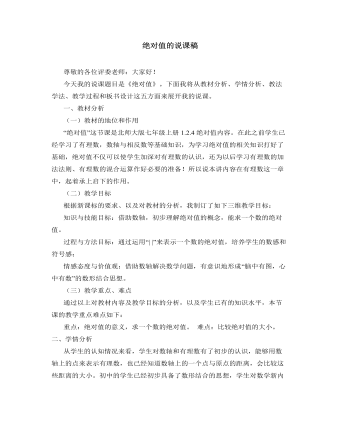
北师大初中数学七年级上册绝对值的说课稿
(三)学以致用,巩固新知为巩固本节的教学重点我再次给出三道问题: 1)绝对值是7的数有几个?各是什么?有没有绝对值是-2的数?2)绝对值是0的数有几个?各是什么? 3)绝对值小于3的整数一共有多少个?先让学生通过小组讨论得出结果,通过以上练习使学生在掌握知识的基础上达到灵活运用,形成一定的能力。(四)总结归纳,知识升华小结时我也将充分发挥学生学习的主动性,发挥教师在教学的启发引导作用,和学生一起合作把本节课所学的内容做一个小结。(五)布置作业,拓展新知布置作业不是目的,目的是使学生能够更好地掌握并运用本节课的内容。所以我会布置这样一个作业:请学生回家在父母的帮助下,找出南方和北方各三个城市的温度,并比较这些温度的大小,并写出每个温度的绝对值进行比较
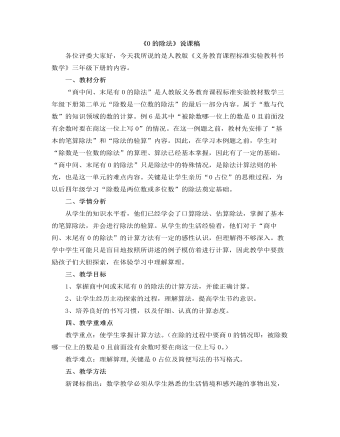
小学数学人教版三年级下册《0的除法》说课稿
一、教材分析“商中间、末尾有0的除法”是人教版义务教育课程标准实验教材数学三年级下册第二单元“除数是一位数的除法”的最后一部分内容。属于“数与代数”的知识领域的数的计算。例6是其中“被除数哪一位上的数是0且前面没有余数时要在商这一位上写0”的情况。在这一例题之前,教材先安排了“基本的笔算除法”和“除法的验算”内容。因此,在学习本例题之前,学生对“除数是一位数的除法”的算理、算法已经基本掌握,因此有了一定的基础。“商中间、末尾有0的除法”只是除法中的特殊情况,是除法计算法则的补充,也是这一单元的难点内容。关键是让学生亲历“0占位”的思维过程,为以后四年级学习“除数是两位数或多位数”的除法奠定基础。
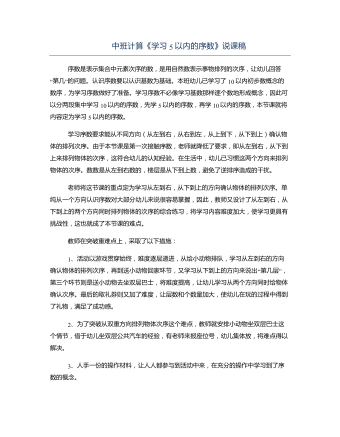
中班计算《学习5以内的序数》说课稿
序数是表示集合中元素次序的数,是用自然数表示事物排列的次序,让幼儿回答“第几”的问题。认识序数要以认识基数为基础。本班幼儿已学习了10以内初步数概念的数序,为学习序数做好了准备。学习序数不必像学习基数那样逐个数地形成概念,因此可以分两段集中学习10以内的序数,先学5以内的序数,再学10以内的序数,本节课就将内容定为学习5以内的序数。学习序数要求能从不同方向(从左到右,从右到左,从上到下,从下到上)确认物体的排列次序。由于本节课是第一次接触序数,老师就降低了要求,即从左到右,从下到上来排列物体的次序,这符合幼儿的认知经验。在生活中,幼儿已习惯这两个方向来排列物体的次序。数数是从左到右数的,楼层是从下到上数,避免了逆排序造成的干扰。
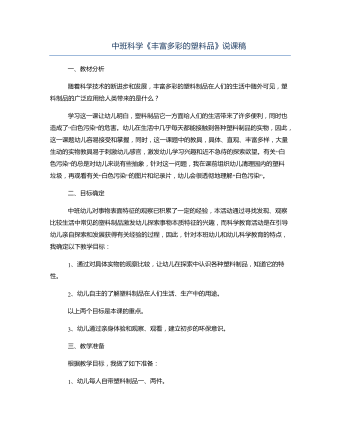
中班科学《丰富多彩的塑料品》说课稿
随着科学技术的断进步和发展,丰富多彩的塑料制品在人们的生活中随外可见,塑料制品的广泛应用给人类带来的是什么?学习这一课让幼儿明白,塑料制品它一方面给人们的生活带来了许多便利,同时也造成了“白色污染”的危害。幼儿在生活中几乎每天都能接触到各种塑料制品的实物,因此,这一课题幼儿容易接受和掌握,同时,这一课题中的教具,具体、直观、丰富多样,大量生动的实物教具易于刺激幼儿感官,激发幼儿学习兴趣和近不急待的探索欲望。有关“白色污染”的总是对幼儿来说有些抽象,针对这一问题,我在课前组织幼儿清理园内的塑料垃圾,再观看有关“白色污染”的图片和纪录片,幼儿会很透彻地理解“白色污染”。
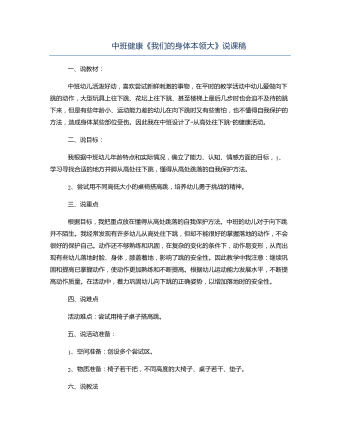
中班健康《我们的身体本领大》说课稿
根据目标,我把重点放在懂得从高处跳落的自我保护方法。中班的幼儿对于向下跳并不陌生。我经常发现有许多幼儿从高处往下跳,但却不能很好的掌握落地的动作,不会很好的保护自己。动作还不够熟练和巩固,在复杂的变化的条件下,动作易变形,从而出现有些幼儿落地时脸、身体,膝盖着地,影响了跳的安全性。因此教学中我注意:继续巩固和提高已掌握动作,使动作更加熟练和不断提高。根据幼儿运动能力发展水平,不断提高动作质量。在活动中,着力巩固幼儿向下跳的正确姿势,以增加落地时的安全性。

小学数学人教版五年级下册《质数和合数》说课稿
设计意图:我运用了引导学生探究发现的教学方法,学生采用观察比较、分类归纳、讨论交流的学习方法。因为“质数和合数”是学生在学习了因数和倍数的基础上进行学习的。因此我抓住新旧知识的连接点,让学生找自己座号的因数,从学生身边熟悉的事物入手,唤起学生亲切的情感,激发他们学习的兴趣。学生是学习的主体,只有让学生参与知识的形成过程,数学知识才会内化学生自己的东西,四人小组讨论交流就是让学生在探讨中提高学习的能力。5、科学总结 实战练习(1)基本练习。完成“做一做”。 (2)强化练习。练习四第1、2题。 (3)综合练习。1-80质数表。验证刚才的判断是否正确。师:通过这节课的学习,你又有了什么新的收获? 你能帮甜甜解决箱子密码的问题了吗?
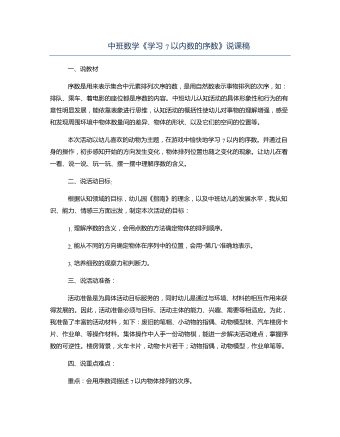
中班数学《学习7以内数的序数》说课稿
序数是用来表示集合中元素排列次序的数,是用自然数表示事物排列的次序,如:排队、乘车、着电影的座位都是序数的内容。中班幼儿认知活动的具体形象性和行为的有意性明显发展,能依靠表象进行思维,认知活动的概括性使幼儿对事物的理解增强,感受和发现周围环境中物体数量间的差异、物体的形状、以及它们的空间的位置等。本次活动以幼儿喜欢的动物为主题,在游戏中愉快地学习7以内的序数。并通过自身的操作,初步感知开始的方向发生变化,物体排列位置也随之变化的现象。让幼儿在看一看、说一说、玩一玩、摆一摆中理解序数的含义。
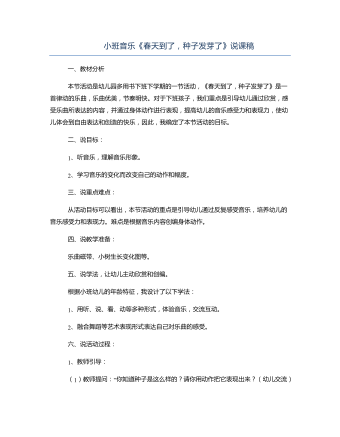
小班音乐《春天到了,种子发芽了》说课稿
1、教师引导:(1)教师提问:”你知道种子是这么样的?请你用动作把它表现出来?(幼儿交流)(2)教师提问:“你知道小树是怎样生长的?你怎样用动作来表现小树生长?”(幼儿交流)(3)幼儿用身体动作的变化来表现小树生长的过程。2、倾听、欣赏音乐,了解音乐结构:(1)教师播放音乐、提问,幼儿倾听表达:“你知道这支乐曲有几段?”“哪一段是说小树生长?哪一段是说小树破土而出?为什么?”(2)幼儿第二次完整欣赏,感受音乐。3、分段欣赏,理解音乐形象并创编动作:(1)请幼儿做小种子,来表现种子的生长过程。(2)请幼儿想像各种不同的种子,并提醒幼儿调整自己的动作幅度。(3)再次引导幼儿用小树生长、摇动的动作表现。(4)教师与幼儿一起来讨论不同的种子所生长的过程。
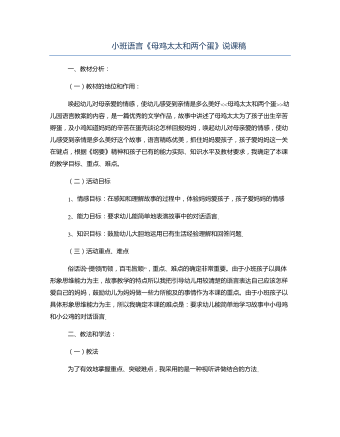
小班语言《母鸡太太和两个蛋》说课稿
唤起幼儿对母亲爱的情感,使幼儿感受到亲情是多么美好<<母鸡太太和两个蛋>>幼儿园语言教案的内容,是一篇优秀的文学作品,故事中讲述了母鸡太太为了孩子出生辛苦孵蛋,及小鸡知道妈妈的辛苦在蛋壳谈论怎样回报妈妈,唤起幼儿对母亲爱的情感,使幼儿感受到亲情是多么美好这个故事,语言精练优美,抓住妈妈爱孩子,孩子爱妈妈这一关在键点,根据《纲要》精神和孩子已有的能力实际、知识水平及教材要求,我确定了本课的教学目标、重点、难点。1、情感目标:在感知和理解故事的过程中,体验妈妈爱孩子,孩子爱妈妈的情感2、能力目标:要求幼儿能简单地表演故事中的对话语言.3、知识目标:鼓励幼儿大胆地运用已有生活经验理解和回答问题.
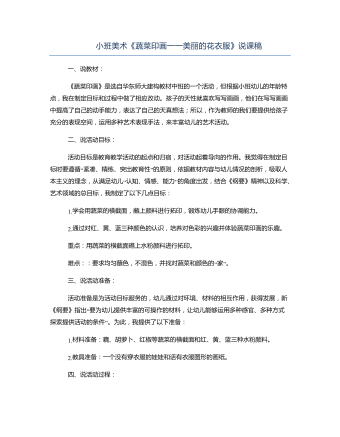
小班美术《蔬菜印画一一美丽的花衣服》说课稿
《蔬菜印画》是选自华东师大建构教材中班的一个活动,但根据小班幼儿的年龄特点,我在制定目标和过程中做了相应改动。孩子的天性就喜欢写写画画,他们在写写画画中提高了自己的动手能力,表达了自己的天真想法;所以,作为教师的我们要提供给孩子充分的表现空间,运用多种艺术表现手法,来丰富幼儿的艺术活动。活动目标是教育教学活动的起点和归宿,对活动起着导向的作用。我觉得在制定目标时要遵循“紧凑、精练、突出教育性”的原则,依据教材内容与幼儿情况的剖析,吸取人本主义的理念,从满足幼儿“认知、情感、能力”的角度出发,结合《纲要》精神以及科学、艺术领域的总目标,我制定了以下几点目标:1.学会用蔬菜的横截面,蘸上颜料进行拓印,锻炼幼儿手眼的协调能力。2.通过对红、黄、蓝三种颜色的认识,培养对色彩的兴趣并体验蔬菜印画的乐趣。重点:用蔬菜的横截面礁上水粉颜料进行拓印。难点::要求均匀蘸色,不混色,并找对蔬菜和颜色的“家”。
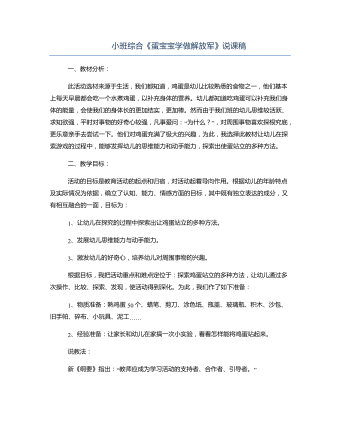
小班综合《蛋宝宝学做解放军》说课稿
此活动选材来源于生活,我们都知道,鸡蛋是幼儿比较熟悉的食物之一,他们基本上每天早晨都会吃一个水煮鸡蛋,以补充身体的营养。幼儿都知道吃鸡蛋可以补充我们身体的能量,会使我们的身体长的更加结实,更加棒。然而由于我们班的幼儿思维较活跃、求知欲强,平时对事物的好奇心较强,凡事爱问:“为什么?”,对周围事物喜欢探根究底,更乐意亲手去尝试一下。他们对鸡蛋充满了极大的兴趣,为此,我选择此教材让幼儿在探索游戏的过程中,能够发挥幼儿的思维能力和动手能力,探索出使蛋站立的多种方法。活动的目标是教育活动的起点和归宿,对活动起着导向作用。根据幼儿的年龄特点及实际情况为依据,确立了认知、能力、情感方面的目标,其中既有独立表达的成分,又有相互融合的一面,目标为:1、让幼儿在探究的过程中探索出让鸡蛋站立的多种方法。2、发展幼儿思维能力与动手能力。3、激发幼儿的好奇心,培养幼儿对周围事物的兴趣。
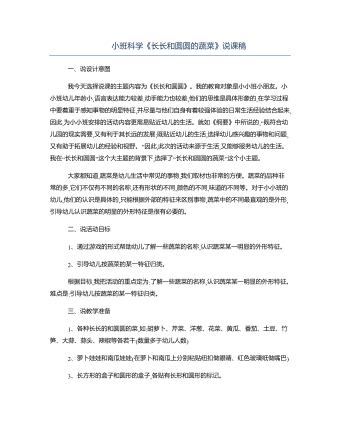
小班科学《长长和圆圆的蔬菜》说课稿
我今天选择说课的主题内容为《长长和圆圆》。我的教育对象是小小班小朋友。小小班幼儿年龄小,语言表达能力较差,动手能力也较差,他们的思维是具体形象的,在学习过程中要着重于感知事物的明显特征,并尽量与他们自身有着较强体验的日常生活经验结合起来,因此,为小小班安排的活动内容更需易贴近幼儿的生活。就如《纲要》中所说的,“既符合幼儿园的现实需要,又有利于其长远的发展;既贴近幼儿的生活,选择幼儿感兴趣的事物和问题,又有助于拓展幼儿的经验和视野。”因此,此次的活动来源于生活,又能够服务幼儿的生活。我在“长长和圆圆”这个大主题的背景下,选择了“长长和圆圆的蔬菜”这个小主题。大家都知道,蔬菜是幼儿生活中常见的事物,我们取材也非常的方便。蔬菜的品种非常的多,它们不仅有不同的名称,还有形状的不同,颜色的不同,味道的不同等。对于小小班的幼儿,他们的认识是具体的,只能根据外部的特征来区别事物,蔬菜中的不同最直观的是外形,引导幼儿认识蔬菜的明显的外形特征是很有必要的。
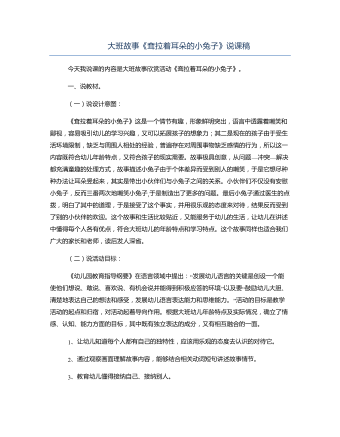
大班故事《耷拉着耳朵的小兔子》说课稿
《耷拉着耳朵的小兔子》这是一个情节有趣,形象鲜明突出,语言中透露着嘲笑和鄙视,容易吸引幼儿的学习兴趣,又可以拓展孩子的想象力;其二是现在的孩子由于受生活环境限制,缺乏与周围人相处的经验,普遍存在对周围事物缺乏感情的行为,所以这一内容既符合幼儿年龄特点,又符合孩子的现实需要。故事极具创意,从问题—冲突—解决都充满童趣的处理方式,故事描述小兔子由于个体差异而受到别人的嘲笑,于是它想尽种种办法让耳朵竖起来,其实是带出小伙伴们与小兔子之间的关系。小伙伴们不仅没有安慰小兔子,反而三番两次地嘲笑小兔子,于是制造出了更多的问题。最后小兔子通过医生的点拨,明白了其中的道理,于是接受了这个事实,并用很乐观的态度来对待,结果反而受到了别的小伙伴的欢迎。这个故事和生活比较贴近,又能服务于幼儿的生活,让幼儿在讲述中懂得每个人各有优点,符合大班幼儿的年龄特点和学习特点。这个故事同样也适合我们广大的家长和老师,读后发人深省。
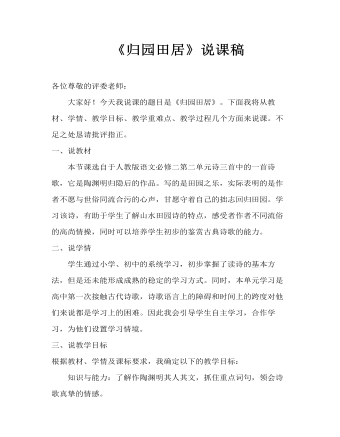
高中语文人教版必修二《归园田居》说课稿
一、说教材本节课选自于人教版语文必修二第二单元诗三首中的一首诗歌,它是陶渊明归隐后的作品。写的是田园之乐,实际表明的是作者不愿与世俗同流合污的心声,甘愿守着自己的拙志回归田园。学习该诗,有助于学生了解山水田园诗的特点,感受者作者不同流俗的高尚情操,同时可以培养学生初步的鉴赏古典诗歌的能力。
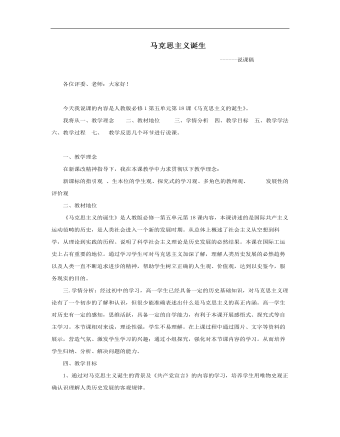
高中历史人教版必修一《马克思主义的诞生》说课稿
一、教学理念在新课改精神指导下,我在本课教学中力求贯彻以下教学理念:新课标的指引观 、生本位的学生观、探究式的学习观、多角色的教师观、 发展性的评价观二、教材地位《马克思主义的诞生》是人教版必修一第五单元第18课内容,本课讲述的是国际共产主义运动范畴的历史,是人类社会进入一个新的发展时期。从总体上概述了社会主义从空想到科学,从理论到实践的历程。说明了科学社会主义理论是历史发展的必然结果。本课在国际工运史上占有重要的地位。通过学习学生可对马克思主义加深了解,理解人类历史发展的必然趋势以及人类一直不断追求进步的精神,帮助学生树立正确的人生观、价值观,达到以史鉴今,服务现实的目的。